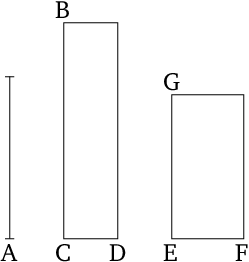Proof: By Euclid
(related to Proposition: Prop. 10.022: Square on Medial Straight Line)

- For since $A$ is medial, the square on it is equal to a (rectangular) area contained by rational (straight lines which are) commensurable in square only [Prop. 10.21].
- Let the square on ($A$) be equal to $GF$.
- And the square on ($A$) is also equal to $BD$.
- Thus, $BD$ is equal to $GF$.
- And ($BD$) is also equiangular with ($GF$).
- And for equal and equiangular parallelograms, the sides about the equal angles are reciprocally proportional [Prop. 6.14].
- Thus, proportionally, as $BC$ is to $EG$, so $EF$ (is) to $CD$.
- And, also, as the (square) on $BC$ is to the (square) on $EG$, so the (square) on $EF$ (is) to the (square) on $CD$ [Prop. 6.22].
- And the (square) on $CB$ is commensurable with the (square) on on $EG$.
- For they are each rational.
- Thus, the (square) on $EF$ is also commensurable with the (square) on on $CD$ [Prop. 10.11].
- And the (square) on $EF$ is rational.
- Thus, the (square) on $CD$ is also rational [Def. 10.4] .
- Thus, $CD$ is rational.
- And since $EF$ is incommensurable in length with $EG$.
- For they are commensurable in square only.
- And as $EF$ (is) to $EG$, so the (square) on $EF$ (is) to the (rectangle contained) by $FE$ and $EG$ [see previous lemma].
- The (square) on $EF$ [is] thus incommensurable with the (rectangle contained) by $FE$ and $EG$ [Prop. 10.11].
- But, the (square) on $CD$ is commensurable with the (square) on on $EF$.
- For they are rational in square.
- And the (rectangle contained) by $DC$ and $CB$ is commensurable with the (rectangle contained) by $FE$ and $EG$.
- For they are (both) equal to the (square) on $A$.
- Thus, the (square) on $CD$ is also incommensurable with the (rectangle contained) by $DC$ and $CB$ [Prop. 10.13].
- And as the (square) on $CD$ (is) to the (rectangle contained) by $DC$ and $CB$, so $DC$ is to $CB$ [see previous lemma].
- Thus, $DC$ is incommensurable in length with $CB$ [Prop. 10.11].
- Thus, $CD$ is rational, and incommensurable in length with $CB$.
- (Which is) the very thing it was required to show.
∎
Thank you to the contributors under CC BY-SA 4.0! 

- Github:
-

- non-Github:
- @Fitzpatrick
References
Adapted from (subject to copyright, with kind permission)
- Fitzpatrick, Richard: Euclid's "Elements of Geometry"
